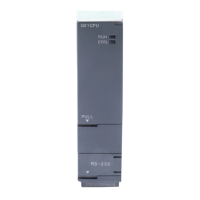A - 19
3.8 I/O Processing and Response Lag
3.8.1 Refresh mode
3.8.2 Direct mode
3.9 Numeric Values which can be Used in Sequence Programs
3.9.1 BIN (Binary Code)
3.9.2 HEX (Hexadecimal)
3.9.3 BCD (Binary Coded Decimal)
3.9.4 Real numbers (Floating-point data)
3.10 Character String Data
CHAPTER4 I/O NUMBER ASSIGNMENT
4.1 Relationship between the Number of Slots and Main Base Unit
4.2 Relationship between No. of Extension Stages and No. of Slots
4.3 Installing Extension Base Units and Setting the Number of Stages
4.4 Base Unit Assignment (Base Mode)
4.5 Definition of I/O Number
4.6 Concept of I/O Number Assignment
4.6.1 I/O numbers of base unit
4.6.2 I/O numbers of remote station
4.7 I/O Assignment by GX Developer
4.7.1 Purpose of I/O assignment by GX Developer
4.7.2 Concept of I/O assignment using GX Developer
4.8 Examples of I/O Number Assignment
4.9 Checking the I/O Numbers
CHAPTER5 MEMORIES AND FILES HANDLED BY CPU MODULE
5.1 Basic Model QCPU
5.1.1 Memory configuration and storable data
5.1.2 Program memory
5.1.3 Standard ROM
5.1.4 Standard RAM
5.1.5 Standard ROM program execution (boot run) and writing
5.2 High Performance Model QCPU, Process CPU, Redundant CPU and Universal Model QCPU
5.2.1 Memory configuration and storable data
5.2.2 Program memory
5.2.3 Program cache memory (Universal model QCPU only)
5.2.4 Standard ROM
5.2.5 Standard RAM
5.2.6 Memory card
5.2.7 Write to standard ROM and Flash card by GX Developer
5.2.8 Automatic all data write from memory card to standard ROM
5.2.9 Execution of standard ROM/memory card programs (boot run)
5.2.10 Details of written files
5.2.11 Specifying the parameters to be valid (parameter-valid drive setting)
5.3 Program File Structure

